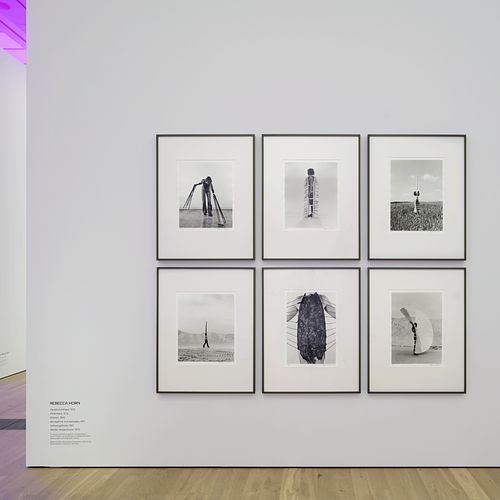AUDIO
Rebecca Horn
Sometimes all it takes is a ribbon, a mask, or feathers to achieve metamorphosis. Rebecca Horn designed apparatuses and prosthetic body parts that transform people: into a unicorn, into a creature with long feathered fingers, and into a figure that blurs the boundaries between human and animal, between everyday life and myth.
Six black-and-white photographs and nine performances, compiled in the video work Performances II, which is shown in cinema format above the staircase, demonstrate how these prostheses are used.These images and videos are not science fiction; instead, they present poetic rituals. Every movement, every gesture becomes an exploration: How does touch feel with elongated fingers? What happens when a mask turns the face into an instrument? Horn’s works play with the boundaries between the familiar and the foreign, between control and surrender.
Physical limitations and vulnerability often characterize her early performances. After a severe illness that left the artist bedridden for a long time, Horn began building devices that protect and simultaneously expand the body. This extension, however, brings new uncertainties: every step, every touch becomes a tentative trial, a transition into another state of being.
Springs, bandages, and mechanical constructions all play a role in a process of transformation. The photographs capture these moments: a body in the process of changing, searching for new possibilities. The videos show the movement, the hesitation, the testing of boundaries.
Rebecca Horn’s art asks: Where does the body end? Where does the “Other” begin? Her works invite us to question our own perceptions—and to discover how much magic transformation can hold.
Six black-and-white photographs and nine performances, compiled in the video work Performances II, which is shown in cinema format above the staircase, demonstrate how these prostheses are used.These images and videos are not science fiction; instead, they present poetic rituals. Every movement, every gesture becomes an exploration: How does touch feel with elongated fingers? What happens when a mask turns the face into an instrument? Horn’s works play with the boundaries between the familiar and the foreign, between control and surrender.
Physical limitations and vulnerability often characterize her early performances. After a severe illness that left the artist bedridden for a long time, Horn began building devices that protect and simultaneously expand the body. This extension, however, brings new uncertainties: every step, every touch becomes a tentative trial, a transition into another state of being.
Springs, bandages, and mechanical constructions all play a role in a process of transformation. The photographs capture these moments: a body in the process of changing, searching for new possibilities. The videos show the movement, the hesitation, the testing of boundaries.
Rebecca Horn’s art asks: Where does the body end? Where does the “Other” begin? Her works invite us to question our own perceptions—and to discover how much magic transformation can hold.
